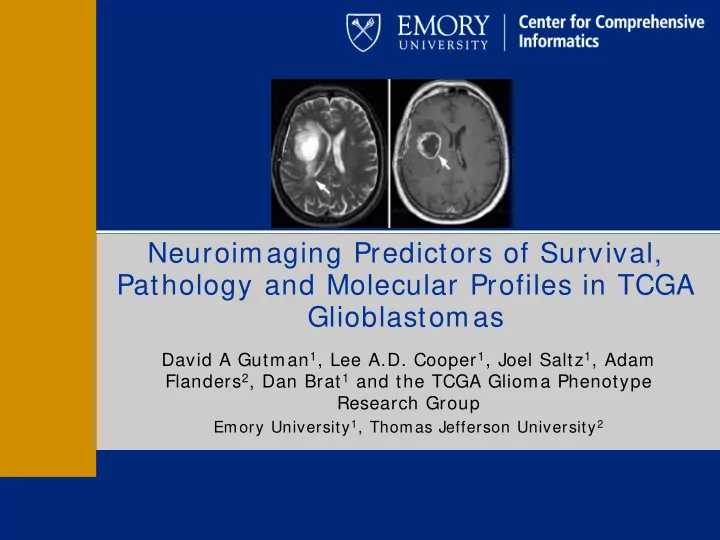

Neuroimaging Predictors of Survival, Pathology and Molecular Profiles in TCGA Glioblastomas David A Gutman 1 , Lee A.D. Cooper 1 , Joel Saltz 1 , Adam Flanders 2 , Dan Brat 1 and the TCGA Glioma Phenotype Research Group Emory University 1 , Thomas Jefferson University 2
In Silico research using public data radiology histology molecular clincal\pathology Integrated Analysis
Glioblastoma Multiforme (GBM) • Most common form of primary brain tumor • Grade IV Astrocytoma • 14 month median survival • First tumor in NCI’s The Cancer Genome Atlas (TCGA) – 500 patients from participating hospitals – mRNA transcription, CGH, sequence, DNA methylation – Neuroimaging – Whole slide pathology images
General Methodology Em ployed in our I n Silico Center • Goal is to develop human and/ or machine based assessments of image features • A standardized imaging imaging feature (dubbed VASARI) was developed • Feature set consists of 30 features that describe the size, location and appearance of the MRI image set • MRI image provides a global view of the tumor – Small tumor adjacent to motor area (e.g. eloquent cortex) has vastly different outcome than a small tumor in frontal lobe
Examples of the feature set
Proportion Enhancing Tumor 1-5% 68-95%
Capturing structured annotations and m arkups AI M Data Service
Systematic assessment of tumor imaging properties Data was obtained from the Cancer Imaging Archive http://cancerimagingarchive.net •Current data set is from 72 patients •Data is now available from ~125 GBM patients that were part of the TCGA data collection •Each case was reviewed and scored independently by 3 neuroradiologists • Consensus measures were obtained and used for this analysis
Imaging Predictors of Survival Neuroimaging Feature p value Edema 0.48 Contrast Enhancing Tumor 0.004 Necrosis 0.37 Non-contrast Enhancing Tumor 0.83 Variable Hazard Ratio p value (95% Confidence Limits) 0.955 (0.933, 0.978) 0.0001 Karn Score 06-33% vs 0-5% 0.528 (0.196, 1.425) 0.025 Contrast Enhancing 34-95% vs 0-5% 1.446 (0.485, 4.312) Tumor
Percent of Contrast Enhancement was significantly associated with shorter survival
Tumor Subtypes and Imaging Features Do tumor genotypes “look” different? •The Mesenchymal subtype were noted to have significantly lower rates of non-contrast enhancement compared to other tumor subtypes (p<0.01). From Verhaak 2010
MR Imaging Results • The Proneural subtype was associated with a low degree of contrast enhancement (0-5% ) (p< 0.01). < 5% Enhancement
I m age based-features and m utation status • EGFR mutant GBMs (11/ 49) were larger based on the T2- weighted FLAIR images than wild type EGFR GBMs (p< 0.05). • TP53 mutant GBMs (9/ 49 patients) were smaller than those that were wild type (p< 0.006)
Conclusions • Imaging based features can provide important prognostic information, even after accounting for other clinical variables • Current qualitative work suggests genotypes may be associated with imaging phenotypes Future Work: – Increase sample size (in progress) – Move from ordinal assessments (0-5% , 6-33% , 34- 67% ) to continuous based assessments of tumor compartments (e.g. volumetrics) – More sophisticated feature extraction to include texture/ size/ location and voxel-based assessments
Acknowledgements Emory University: Lee Cooper, Doris Gao, Tarun D Aurora, Williiam Dunn Jr, Scott N Hwang, Chad A Holder, Dima Hammoud, Carlos Moreno, Arun Krishnan, Seena Dehkharghani, Joel Saltz, Dan Brat Thomas Jefferson: Adam Flanders Henry Ford: Lisa Scarpace, Rajan Jain , Tom Mikkelsen SAIC-Frederick: John Freymann, Justin Kirby Boston University: Carl Jaffe NCI: Erich Huang, Bob Clifford UVA: Max Wintermark, Prashant Raghavan Brigham & Womens, Harvard: Rivka Colen Northwestern University: Pat Mongkolwat The TCGA Glioma Research Group If you have imaging data for TCGA contributed cases available and would like to contribute, please contact kirbyju@mail.nih.gov (Justin Kirby) or John Freymann (john freymannj@mail.nih.gov ) as we can help with deidentification and sharing This work was supported in part with funds from the Georgia Cancer Coalition and the NCI funded In Silico Brain Tumor Research Center funded
Recommend
More recommend